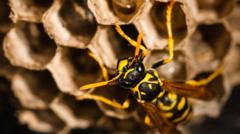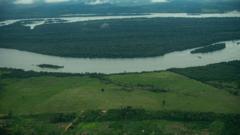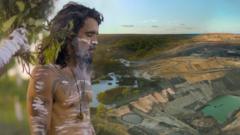Recent observations from the European Space Agency suggest that a piece of the Soviet-era spacecraft Kosmos 482, which was launched in 1972 on a mission to Venus, has likely re-entered Earth’s atmosphere after orbiting for over 51 years. Initially aimed at exploring the harsh conditions of Venus, the probe failed to exit Earth's orbit and subsequently fragmented into four pieces, which continuously orbited the planet for decades.
The EU Space Surveillance and Tracking centre (SST) reported that one of these fragments, presumed to be the lander, re-entered at approximately 06:16 GMT (07:16 BST) on Saturday. It's currently unknown whether this debris landed or incinerated during its atmospheric descent. The specifics surrounding its re-entry path are also uncertain; however, with 70% of the Earth covered in water, the likelihood of it causing harm is minimal.
Stijn Lemmens, a senior analyst with the European Space Agency, noted, "It's much more likely that you win the lottery than that you get impacted by this piece of space debris." Kosmos 482's lander was robustly built to endure the extreme conditions on Venus, featuring a heat shield designed to potentially withstand re-entry into Earth's atmosphere. Nonetheless, the spacecraft's parachute system, intended for descent on Venus, has likely deteriorated over five decades in space.
The re-entry of such human-made objects into the atmosphere is a common occurrence, with larger spacecraft making their descent weekly and smaller objects daily, most of which disintegrate before reaching the ground. In recent years, other notable re-entries include China’s Long March 5B booster over the Indian Ocean in 2022 and the Tiangong-1 space station, which primarily burned up over the Pacific in 2018.
International space agencies continue to monitor Kosmos 482, and Lemmens remarked on the importance of future spacecraft designs that allow them to safely manage their own orbits and re-entries. This advancement would enhance the predictability of landing sites, minimize the dangers linked to space debris, and ultimately safeguard people and property while addressing the increasing environmental impact of orbiting debris.
The EU Space Surveillance and Tracking centre (SST) reported that one of these fragments, presumed to be the lander, re-entered at approximately 06:16 GMT (07:16 BST) on Saturday. It's currently unknown whether this debris landed or incinerated during its atmospheric descent. The specifics surrounding its re-entry path are also uncertain; however, with 70% of the Earth covered in water, the likelihood of it causing harm is minimal.
Stijn Lemmens, a senior analyst with the European Space Agency, noted, "It's much more likely that you win the lottery than that you get impacted by this piece of space debris." Kosmos 482's lander was robustly built to endure the extreme conditions on Venus, featuring a heat shield designed to potentially withstand re-entry into Earth's atmosphere. Nonetheless, the spacecraft's parachute system, intended for descent on Venus, has likely deteriorated over five decades in space.
The re-entry of such human-made objects into the atmosphere is a common occurrence, with larger spacecraft making their descent weekly and smaller objects daily, most of which disintegrate before reaching the ground. In recent years, other notable re-entries include China’s Long March 5B booster over the Indian Ocean in 2022 and the Tiangong-1 space station, which primarily burned up over the Pacific in 2018.
International space agencies continue to monitor Kosmos 482, and Lemmens remarked on the importance of future spacecraft designs that allow them to safely manage their own orbits and re-entries. This advancement would enhance the predictability of landing sites, minimize the dangers linked to space debris, and ultimately safeguard people and property while addressing the increasing environmental impact of orbiting debris.






















